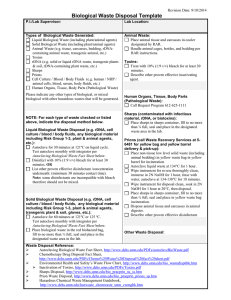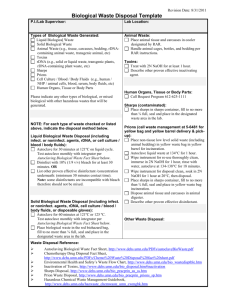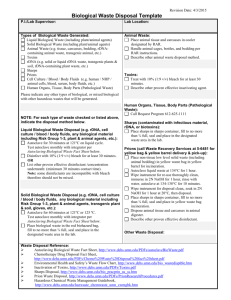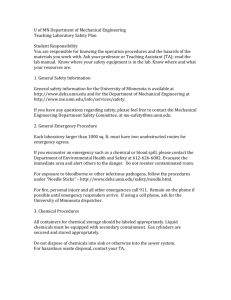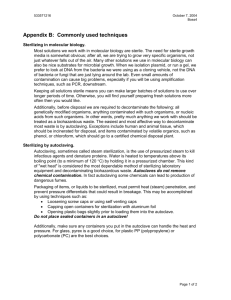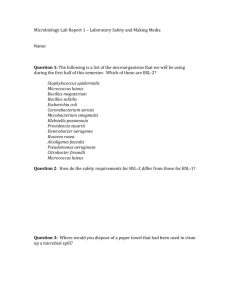CBS Lab Safety and Chemical Waste Refresher training 2007
advertisement
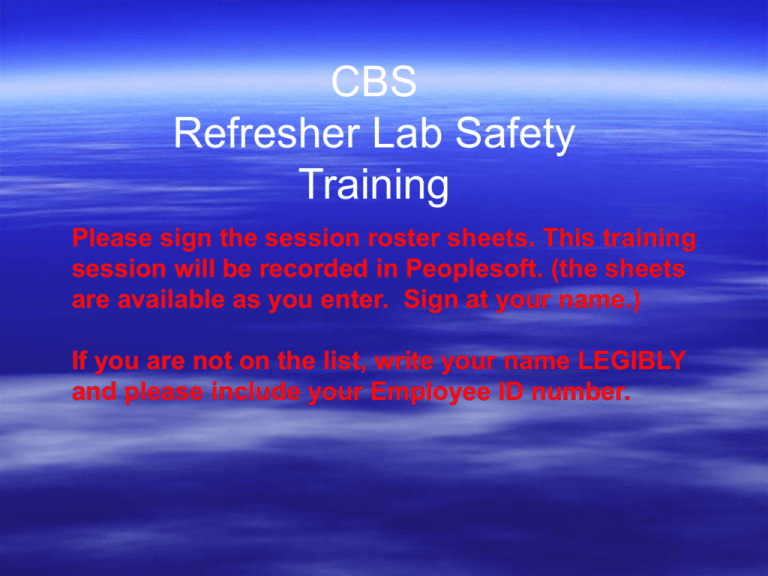
CBS Refresher Lab Safety Training Please sign the session roster sheets. This training session will be recorded in Peoplesoft. (the sheets are available as you enter. Sign at your name.) If you are not on the list, write your name LEGIBLY and please include your Employee ID number. David Okita Biochemistry, Molecular Biology & Biophysics 6-155 Jackson Hall okita001@umn.edu (612) 624-7107 This sessions covers Lab Safety, Chemical Safety and Chemical Waste Management Refresher Training Only! General Lab Safety Training Required for All All University of Minnesota faculty, staff, and students that work in or supervise individuals working in laboratories are required by law to receive training regarding safety issues and practices in their work place. Training is mandated by both the federal Laboratory Safety Standard and the Minnesota Employee Right to Know Act and is required upon hire, at refresher intervals (at least annually), and whenever a new procedure is introduced. Environmental Health and Safety (DEHS) provides basic safety training for new faculty, staff, and students. Three web-based tutorials that are mandatory for all lab workers are available at http://www.dehs.umn.edu/training_newlabsafety.htm Lab Specific Training Encouraged for All Each Principal Investigator and/or laboratory supervisor is responsible for ensuring that employees are provided with training addressing specific hazards (chemical, physical, and biological) in their laboratory or work area. Training must address the specific hazards of the procedure and personal protective equipment available to reduce the potential risk of exposure to the particular hazard. Training must be provided at the time of an employee's initial work assignment and prior to assignments involving any new potentially hazardous situations. Refresher training must be provided annually. Specific Material Use Training In addition to general Lab Safety and Chemical Waste Management training, work with the following materials requires additional training: • Bloodborne and Other Pathogens if work involves human blood, human body fluids, human cells (including cell lines), unfixed human tissue, and/or infectious agents (viruses, bacteria, fungi, rickettsia, prions), Online tutorial. Must be renewed or reviewed every year. http://www.dehs.umn.edu/bio_pracprin_blood_bpt.htm • Hazardous Shipping for workers who package and ship hazardous materials, including infectious substances or diagnostic specimens. In Person training sessions. Once every 2 years. http://www.dehs.umn.edu/training_shiphazmat.htm. • Controlled Substance users must complete training through Regulatory Affairs. One time on person training session. http://www.research.umn.edu/regaffairs/ControlledSub/inde x.html • Animal Users must complete training through IACUC, http://www.research.umn.edu/iacuc/training/ . • Radiation training is required by the Nuclear Regulatory Commission (NRC) for persons who work in or frequent a radioactive materials area. For further information call Environmental Health and Safety at 612-626-6002. Updates •Compliance Inspections •Injury Reports Inspections by the County, AAALAC, EPA, DEHS and your departmental RSO have indicated some improvements but we still have some problems. Good News! Signs of Improvement •Less food in the labs •Better Labeling and Segregation of Hazardous Waste •The EPA really liked the Posters and and saw lots of Yellow labels •Better Lab Attire Proper Lab Attire Chapter 3, section 2 of the University of Minnesota Lab Safety Plan Skin must be protected from hazardous liquids, gases and vapors, proper basic attire is essential in the laboratory. Long hair should be pulled back and secured and loose clothing (sleeves, bulky pants or skirts) avoided to prevent accidental bare feet, sandals and open-toed or perforated shoes are not permitted in any laboratory. Short pants and short skirts are not permitted unless covered by a lab coat. Long pants should be worn to cover contact with chemicals or open flames. However, skin that could be exposed during a spill. Wear shoes that cover your skin Good Bad Areas That Need Improvement Chemical Storage •Top Issue: Incompatible chemicals stored together (e.g. acids and bases or organics and in-organics stored together) •Chemicals and Solvents without secondary containment •Chemical Labeling Containers not labeled •Sharps Containers Overfilled or improper items (e.g. pipettes) Do Not Recap Needles •Eyewashes need to be inspected and documented weekly! Injuries and Accidents! Numerous lab accidents. Explosions, Fires, Burns, Cuts, Spills and Fainting! A few injuries requiring Workman’s Compensation were reported. How can we avoid these? •Review your SOPs and make sure to address the specific hazards for each procedure! •Lab Audits Reporting Injuries Forms available at the U of M forms library http://process.umn.edu/groups/ppd/documents/main/formho me.cfm Or Contact your Department RSO Autoclaving Biological Waste What is Autoclaved: All disposable lab ware contaminated with potentially infectious materials (blood, body fluids, human cell culture media, bacteria culture media) Except Pasteur pipettes, Pasteur pipettes should be disposed of in red sharps container. Culture plates Culture media Animal cages and bedding from infected animals Autoclaving Biological Waste Procedure: Place materials in a clear autoclave bag (available from U stores). Do not use the RED or ORANGE biohazard bags to autoclave waste since these bags cannot be disposed of as regular trash. No Biohazard symbol should be visible. The University pays a premium to dispose biohazard waste. Bag should be loosely packed and not more than 3/4 full. Do not seal bag shut. If using a rubber band, place rubber band on loosely, do not twist opening should be at least one inch in diameter. Using an industrial strength permanent marker write in Large Clearly Identifiable Markings. Your PI Last Name, Room Number and the Date you prepared the waste for autoclaving. Autoclaving Procedure Use autoclave indicator tape on outside of bag to show that waste has been processed. Place waste material on a large, metal, leak-proof tray. Metal containers transfer heat more efficiently than plastic containers. Container should be large enough and shallow enough to allow for ample steam circulation. If autoclaving more than one bag at a time, be sure there is ample room between the bags so steam circulation is not impaired. Autoclave at 121ーC for 60 minutes. After autoclaving is complete, tape bag shut or tighten rubber band and place in regular trash receptacle. Liquid Waste To autoclave liquid waste, place liquid in beaker or flask, not in autoclave bag. Autoclaved liquid culture waste can be sewered unless hazardous chemical waste is present. If hazardous chemical waste is present follow procedures in the Hazardous Chemical Waste Management Guidebook at http://www.dehs.umn.edu/hazwaste_chemwaste_umn_cw mgbk_sec2.htm. Do not sewer melted agar as it will congeal and clog the plumbing. Autoclave Testing: Autoclave indicator tape does not prove decontamination effectiveness. For highest confidence in decontamination effectiveness, each load should be tested. If autoclaving for less than 60 minutes, each load must be tested. 3M Comply (Thermalog) chemical integrator strips provide immediate test results. These can be purchased from U Stores - CX12607. Attach the indicator strip to a stick or string and put in the center of the load.Retrieve after autoclaving for confirmation that the entire load has been exposed to the conditions necessary for decontamination.If the indicator reads unsafe, autoclave again. Let be careful out there! •Remember to do your lab audits •Check to be sure your protocols cover safety hazards and mitigation plans. • Contact your Department RSO •Getting rusty? You might consider re-doing the initial training online at http://www.dehs.umn.edu/training_newlabsafety.htm Laboratory Poster Р Take One W ith You Today! Remember You must sign the session roster sheets for this training to be recorded in Peoplesoft (the sheets are available as you enter. Sign at your name.) If you are not on the list, write your name LEGIBLY at the end of the roster. Please include ID number too.
